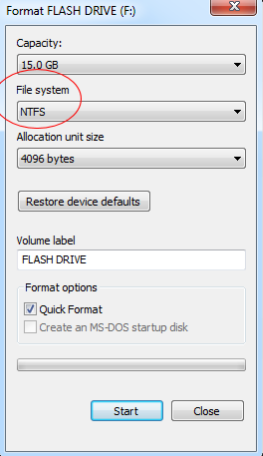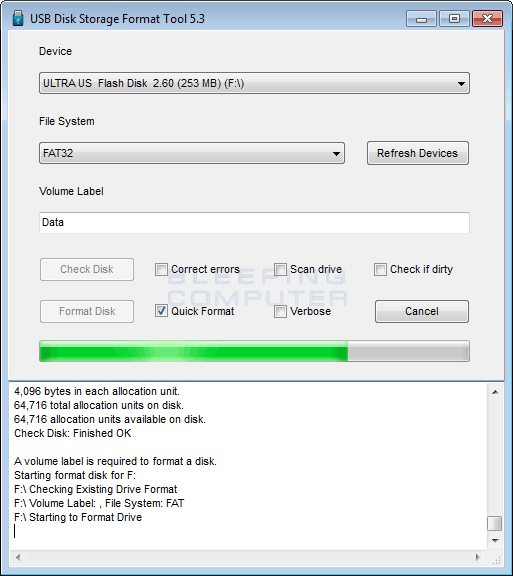How To Format A Usb Drive
- Reformat Portable Hard Drive Windows 10
- How To Format A Usb Drive Windows 10
- How To Reformat A Usb Drive
Format USB exFAT or FAT32? When format a USB flash drive, you may wonder which file system is the most suitable one, exFAT or FAT32? ExFAT and FAT32 are most commonly used file systems on removable storages like SDXC, SDHC, micro SD card, USB flash drive, USB hard drive, Pen drive, Thumb drive, etc. To make your decision more reliable, you’d better have a brief understanding about those file systems.
How to format a flash drive to NTFS on Windows. Plug the USB drive into a PC that's running Windows. Open File Explorer. Right-click Removable Disc (or USB Drive) in the left pane. From the pop-up menu, select Format. In the Format Removable Disc (or USB Drive) box, make sure File system is set to NTFS. Select Start to begin formatting. 15 thoughts on “ How to Format USB Flash Drive ” Kathryn Bass April 11, 2013 I just recently bought a computer package from Best Buy that included a computer with Windows 8 (unfortunately) with a few essentials including an 8g flash drive. Search for 'My PC' in the bottom LHS search window. W10 responded with 'This PC' and displayed a schematic which will be familiar to you. Right click on the USB drive icon and select format from the tabulation. How to use DiskPart to clean and format a storage drive not working on Windows 10. Such as a USB flash drive or hard drive, or even an SD Card that isn't working correctly because of data.
File Allocation Table 32 (FAT32) is an older file system comparing to Extended File Allocation Table (exFAT). It has higher compatibility among different operating systems and old devices, such as Linux, PS3, PS4, and XBOX and so on. FAT32 uses space more efficiently through small cluster size. It is a robust and flexible file system as well. It is not a bad choice to format to FAT32 with. ExFAT is a relative new file system that was first introduced to us in 2006. The most outstanding feature of this file system is that it makes up for the limit of FAT32, maximum file 4GB in size.
Reformat Portable Hard Drive Windows 10
In addition, exFAT works well with large-sized partition up to 8 TB in size. In other words, you can store the single file larger than 4GB on a partition larger than 2TB with exFAT file system.
There is no doubt that exFAT has its own disadvantages as well, which is something you should know before you format USB to exFAT. Compared with FAT32, exFAT has less compatibility.


For instance, PS4 supports exFAT yet PS3 does not. Format USB exFAT allocation unit size in Windows Allocation unit size, also known as cluster size, is the smallest amount of disk space that can be used to hold a file. When you format a partition in Windows Disk Management or File Explorer, you’ll find there is a drop-down list next to Cluster size/Allocation unit size option. However, Command Prompt will format a partition without specifying cluster size. The matter that affects how you choose cluster size is based on your own needs. To be specific, if you have lots of small files, it is suggested to keep the cluster size small to avoid space waste. On the contrary, if you have a lot of large files to store, keep the cluster size higher will reduce the number of units and speed up reading and writing.
Please note that some large files use small units, and they just large in size. For example, system files needs small allocation unit size to improve performance.
Online bijoy to unicode converter. Unicode to Bijoy Converter: This converter will help you to convert your bangla bijoy Ascii text to convert Unicode text. You can get help from it to develop your.
Nowadays, large disk capacity makes the difference of cluster size small, so the cluster size shouldn’t be a determine factor on device performance. Text message app download. If you have no idea about your file size and unit, Default is a good choice.
It will choose a proper cluster size for your USB stick based on the partition size. According to Microsoft, the executing standard of default cluster size for exFAT is: 7MB – 256MB: 4KB; 256MB – 32GB: 32KB; 32GB – 256TB: 128KB; >256TB: Not supported; Tips: The available allocation unit size choices you may see in Windows are Default, 512 Byte, 1024 Byte, 2048 Byte, 4096 Byte, 8192 Byte, 16KB, 32KB, 64KB, and sometimes 128KB.
How To Format A Usb Drive Windows 10
How to format USB to exFAT using CMD? After knowing the basic knowledge about exFAT file system and its allocation unit size, let’s get to know how to format flash drive in exFAT. In the first place, connect your USB drive to your computer and make sure it can be detected. Run diskpart as administrator. Type: list disk. Type: select disk n (where n is the number of your USB drive).
How To Reformat A Usb Drive
Type: list partition. Type: select partition # (where # is the number of the partition on flash drive). Type: format fs=exfat. The exFAT formatting progress should be completed in a short while. If you partitioned USB key in multiple partitions before, you can clean the drive, create a new primary partition and then format it to exFAT entirely. It is worth mentioning that Windows File Explorer supports exFAT formatting USB drive as well.